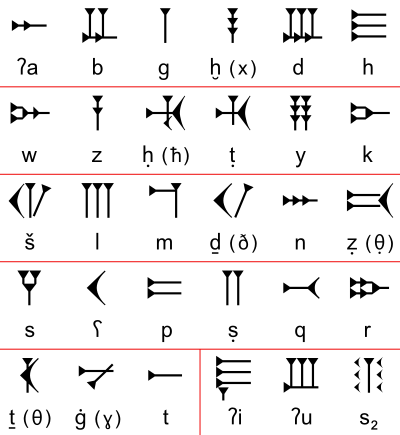Ugaritiska alfabetet
Det ugaritiska alfabetet uttrycktes med hjälp av en särskild form av kilskrift som uppstod omkring år 1500 f.Kr. Alfabetet användes för att, på lertavlor, skriva det inhemska ugaritiska språket, och återupptäcktes i och med att den kanaaneiska staden Ugarit grävdes ut, se ugaritisk litteratur.
Via det feniciska alfabetet (ej kilskriftsbaserat) ska detta kilskriftsalfabet i sin tur ha influerat det grekiska alfabetet. I likhet med de flesta (akkadiska utgör här ett undantag) andra semitiska språk består det ugaritiska alfabetet enbart av konsonanter.
Bokstäver i Ugaritiska alfabetet
Ugaritiska alfabetet finns i Unicode-teckenuppsättningen på teckenplats U+10380 - U+1039F.
𐎀 ʾa ʔa
𐎁 b b
𐎂 g g
𐎃 ẖ x
𐎄 d d
𐎅 h h
𐎆 w w
𐎇 z z
𐎈 ḥ ħ
𐎉 ṭ ṭ
𐎊 y j
𐎋 k k
𐎌 š ʃ
𐎍 l l
𐎎 m m
𐎟 ḏ ð
𐎐 n n
𐎑 ẓ ẓ
𐎒 s s
𐎓 ʿ ʕ
𐎔 p p
𐎕 ṣ ṣ
𐎖 q q
𐎗 r r
𐎘 ṯ θ
𐎙 ġ ɣ
𐎚 t t
𐎛 ʾi ʔi
𐎜 ʾu ʔu
𐎝 s2 ś
𐎟 ordavskiljare
Externa länkar
Media som används på denna webbplats
A table of the letters of the Ugaritic cuneiform alphabet, with corresponding conventional Latin-alphabet transcriptions. Where such specialist "Semitological" symbols are somewhat divergent from more widely-understood general linguistic IPA symbols, an equivalent IPA symbol follows in parentheses (except that no attempt is made to interpret underdots for "emphatic" consonants in terms of IPA; note that the use of IPA symbols is not intended to be any kind of exact phonetic reconstruction of details of ancient Ugaritic pronunciation). The symbols "y" and "š", which are "Americanist" as well as Semitological, do not have their IPA equivalents [j] and [ʃ] listed in the chart. Since there is not much clue as to the exact pronunciation of the last letter of the alphabet, conventionally transcribed "s2" or "s̀", it is also not given a quasi-IPA equivalent.
The letters ṭ ṣ ẓ q wrote sounds which were the "emphatic" counterparts to "non-emphatic" t s θ k, but it is not known what the exact phonetic nature of such emphasis contrasts was in ancient Ugaritic. Certain confusions or semi-coalescences of letters (such as between ẓ and ġ etc.) hint at sound changes within Ugaritic...
The vertical red line in the last row of the table divides the basic 27 Ugaritic letters (presumably adapted from an early non-Cuneiform alphabet) from the last three letters, which seem to have been added within Ugaritic (originally to transcribe foreign words or languages).
The only punctuation was a word divider (a short vertical stroke), not shown in the table.
Note that some of the character names included in the Unicode standard (listing at https://www.unicode.org/charts/PDF/U10380.pdf ) seem to be rather speculative and hypothetical, while other names are strangely and anachronistically taken from the Greek alphabet etc. These Unicode character names are not useful for linguistic or philological research.
